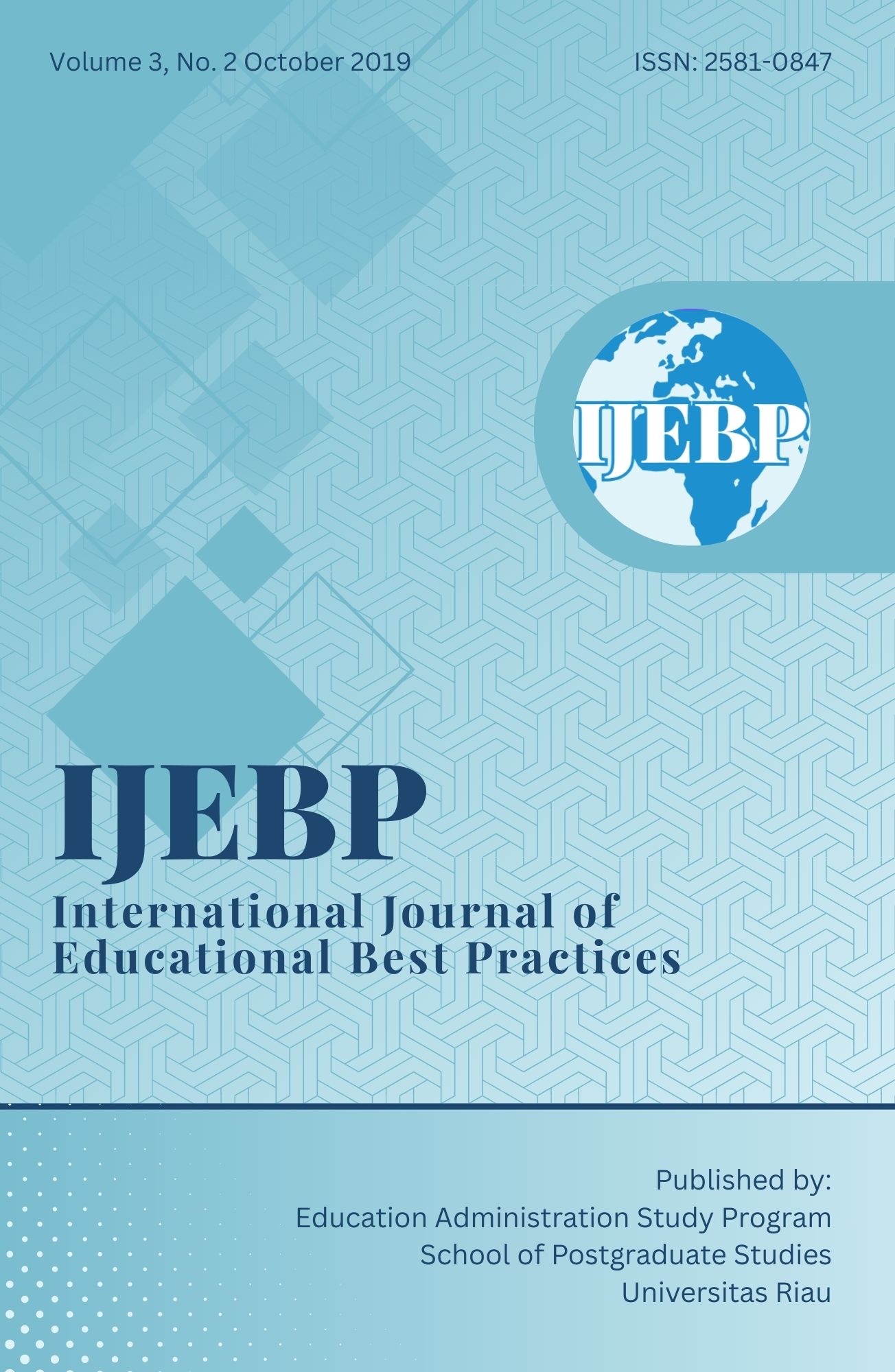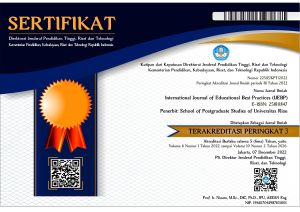THE EFFECTS OF DISTRIBUTED LEADERSHIP ON TEACHERS’ COLLECTIVE EFFICACY AND PROFESSIONAL LEARNING COMMUNITY
DOI:
https://doi.org/10.31258/ijebp.3.2.10-27Keywords:
Disributed Leadership, Teachers' collective efficacy, Professional Learning Community, EffectAbstract
Distributed leadership offers a new-thinking in transforming the school's leadership. Teachers' collective efficacy and professional learning community have been identified to have a strong influence on improving the teaching quality of teachers. This article examines the effects of distributed leadership of secondary school administrators on teacher collective efficacy and professional learning community. The literature suggests that distributed leadership perspective is a good alternative strategy to improve the quality of educational institutions, but empirical evidence showing the effects of distributed leadership on teachers’ collective efficacy and professional learning community that can improve the quality of teacher’s teaching is limited. Data were collected from 592 teachers working in secondary schools in Negeri Sembilan, Malaysia. Distributed leadership of secondary school administrators were determined with Distributed Leadership Inventory developed by Hulpia (2009) while teachers’ collective efficacy was determined using the Collective Efficacy Scales developed by Goddard and Hoy (2003) and professional learning community was determined with the School Professional Staff as Learning Community Questionnaire developed by Hord (1996). Data analysis was done based on Structural Equation Modeling using AMOS software. Regression weight, variance and squared multiple correlations tests were used in data analysis. In conclusion, a strong positive relationship was revealed between distributed leadership of secondary school administrators on teachers’ collective efficacy and professional learning community. Distributed leadership of secondary school administrators was also a significant predictor of teachers’ collective efficacy and professional learning community.
References
Abdullah, M. Y., Zain, S., Mohamad, B., Ambotang, A. S., Taat, M. S. & Talip, R. (2012). Kepimpinan Instruksional Pengetua: Cabaran Dan Harapan. Utusan Borneo B4.
Fullan, M. (2010). All Systems Go: The Change Imperative for Whole System Reform. Corwin Press.
Goddard, R. D., Hoy, W. K. & Hoy, A. W. (2004). Collective Efficacy Beliefs: Theoretical Developments, Empirical Evidence, and Future Directions. Educational researcher, 33(3),3-13.
Goddard, R. D., Hoy, W. K. & Hoy, A. W. (2004). Collective Efficacy Beliefs: Theoretical Developments, Empirical Evidence, and Future Directions. Educational researcher 33(3): 3-13/
Gronn, P. (2002). Distributed Leadership. Dlm. Leithwood, K. & Hallinger, P. (pnyt.). Second International Handbook of Educational Leadership and Administration, hlm. 653-696. Dordrecht: Kluwer Academic Publisher.
Hallinger, P. (2003). Leading Educational Change: Reflections on the Practice of Instructional and Transformational Leadership. Cambridge Journal of education 33(3): 329-352.
Hallinger, P. (2005). Instructional Leadership and the School Principal: A Passing Fancy That Refuses to Fade Away. Leadership and Policy in Schools 4(3): 221-239.
Hallinger, P. (2011). Leadership for Learning: Lessons from 40 Years of Empirical Research. Journal of Educational Administration 49(2): 125-142.
Hallinger, P. & Murphy, J. F. (2013). Running on Empty? Finding the Time and Capacity to Lead Learning. NASSP Bulletin 97(1): 5-21.
Harris, A. (2003). Teacher Leadership as Distributed Leadership: Heresy, Fantasy or Possibility? School leadership & management 23(3): 313-324.
Harris, A. (2008). Distributed Leadership: According to the Evidence. Journal of Educational Administration 46(2): 172-188.
Harris, A. & Spillane, J. (2008). Distributed Leadership through the Looking Glass. Management in Education 22(1): 31.
Hord, S. E. (2004). Learning Together: Leading Together. Changing Schools through Plcs. New York: Teachers College Press.
Hord, S. M. (2008). Evolution of the Professional Learning Community. National Staff Developement Council 29(3): 10-13.
Hord, S. M. (2009). Professional Learning Communities. National Staff Developement Council 30(1): 40-43.
Horng, E. L., Klasik, D. & Loeb, S. (2010). Principal's Time Use and School Effectiveness. American Journal of Education 116(4): 491-523.
Hulpia, H., Devos, G. & Rosseel, Y. (2009a). The Relationship between the Perception of Distributed Leadership in Secondary Schools and Teachers' and Teacher Leaders' Job Satisfaction and Organizational Commitment. School Effectiveness and School Improvement 20(3): 291-317.
Hulpia, H., Devos, G. & Van Keer, H. (2009). The Influence of Distributed Leadership on Teachers’ Organizational Commitment: A Multilevel Approach. The Journal of Educational Research 103(1): 40-52.
James Ang, J. E. & Balasandran, R. (2009). Kepimpinan Instruksional. Satu Panduan Praktikal. Kuala Lumpur: PTS Professional.
Jazzar, M. & Algozzine, B. (2007). Keys to Successful 21st Century: Educational Leadership. United States: Pearson Education, Inc.
Kowalski, T. J. (2010). The School Principal. Visionary Leadership and Competent Management. New york: Routledge Taylor and Francis Group.
Krejcie, R. V. & Morgan, D. W. (1970). Determining Sample Size for Research Activities. Educ Psychol Meas.
Leithwood, K., Harris, A. & Hopkins, D. (2008). Seven Strong Claims about Successful School Leadership. School Leadership and Management 28(1): 27-42.
Leithwood, K. & Louise, K. S. (2012). Linking Leadership to Student Learning. San Francisco, USA. Jossey-Bass, A Wiley Imprint.
Marzano, R. J., Waters, T. & Mcnulty, B. A. (2005). School Leadership That Works: From Research to Results. ERIC.
Mascall, B., Leithwood, K., Strauss, T. & Sacks, R. (2009). The Relationship between Distributed Leadership and Teacher's Academic Optimism. Dlm. Harris, A. (pnyt.). Distributed Leadership: Different Perspectives hlm. 81-100. London: Springer.
Muijs, D. & Harris, A. (2006). Teacher Led School Improvement: Teacher Leadership in the Uk. Teaching and teacher education 22(8): 961-972.
Spillane, J. & Diamond, J. (2007). Taking a Distributed Perspective. Dlm. Spillane, J. & Diamond, J. (pnyt.). Distributed Leadership in Practice, hlm. 1-15. New York: Teachers College.
Spillane, J. P., Halverson, R. & Diamond, J. B. (2001). Investigating School Leadership Practice: A Distributed Perspective. Educational researcher 30(3): 23-28.
Spillane, J. P., Halverson, R. & Diamond, J. B. (2004). Towards a Theory of Leadership Practice: A Distributed Perspective. Journal of Curriculum Studies 36(1): 3-34.
Timperley, H. S. (2005). Distributed Leadership: Developing Theory from Practice. Journal of curriculum studies 37(4): 395-420.
Uhl-Bien, M. (2006). Relational Leadership Theory: Exploring the Social Processes of Leadership and Organizing. The Leadership Quarterly 17(6): 654-676.
Wahlstrom, K., Louis, K., Leithwood, K. & Anderson, S. (2010). Investigating the Links to Improved Student Learning: Executive Summary of Research Findings. Retrieved from The Wallace Foundation website: http://www. wallacefoundation.org
Wahlstrom, K. L. & Louis, K. S. (2008). How Teachers Experience Principal Leadership: The Roles of Professional Community, Trust, Efficacy, and Shared Responsibility. Educational administration quarterly 44(4): 458-495.
Zainudin, A. (2012a). Research Methodology and Data Analysis. Shah Alam: UiTM Press.





